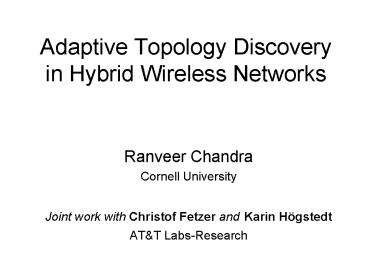Adaptive Topology Discovery in Hybrid Wireless Networks - PowerPoint PPT Presentation
Title:
Adaptive Topology Discovery in Hybrid Wireless Networks
Description:
Adaptive Topology Discovery in Hybrid Wireless Networks. Ranveer Chandra. Cornell University ... Hybrid Wireless Network: Ad hoc network with slow moving nodes ... – PowerPoint PPT presentation
Number of Views:29
Avg rating:3.0/5.0
Title: Adaptive Topology Discovery in Hybrid Wireless Networks
1
Adaptive Topology Discovery in Hybrid Wireless
Networks
- Ranveer Chandra
- Cornell University
- Joint work with Christof Fetzer and Karin
Högstedt - ATT Labs-Research
2
Problem Description
- Hybrid Wireless Network
- Ad hoc network with slow moving nodes
- Presence of at least one relatively static node
- Nearly all the links are bidirectional
- A coordinator wants to know the topology of the
network. - All the nodes
- All the links
3
Hybrid Wireless Network
- Applications Home, office networks, mesh
networking
Coordinator
A
(A, D) (A, B) (B, D) (B, C) (D, E) (E, C)
D
B
E
C
4
Issues In Ad Hoc Networks
- Communication is expensive
- Unreliable links
- No a priori knowledge of neighbors
- Possibility of unidirectional links
- Links could become stale due to mobility
5
Outline of the Talk
- Introduction
- Basic protocol
- Enhancements for
- Unreliable broadcasts
- Low mobility (low overhead)
- High mobility (overhead depends on mobility)
- Performance
- Conclusion
6
Protocol Overview
- Diffusion Phase
- Propagates request through network
- Establishes neighborhood information
- Builds tree structure
- Gathering Phase
- Propagates neighborhood information back along
tree structure
7
Diffusion Phase
Parent Children
8
Diffusion Phase
coord
Parent Children
9
Diffusion Phase
Parent Children
A
A
coord
coord
coord
A
10
Diffusion Phase
Parent Children A
B
A
A
B
11
Diffusion Phase
Parent Children A
D
B
B
12
Diffusion Phase
Parent Children A
C
A
A
13
Gathering Phase
LA coord, B, C
Lcoord A
LB A, D
dLA
dLcoord
dLB
LD B, C
LC A, D
dLD
dLC
14
Gathering Phase
LA coord, B, C
Lcoord A
LB A, D
dLA LC
dLcoord
dLB LD
LD
LC
LD B, C
LC A, D
dLD
dLC
15
Gathering Phase
LA coord, B, C
Lcoord A
LB A, D
dLA LB, LC, LD
dLcoord
dLB LD
LB, LD
LD B, C
LC A, D
dLD
dLC
16
Gathering Phase
LA coord, B, C
Lcoord A
LB A, D
dLA LB, LC, LD
dLB LD
dLcoord LA, LB, LC, LD
LA, LB, LC, LD
LD B, C
LC A, D
dLD
dLC
17
Gathering Phase
A
C
B
E
D
18
Node Or Link Failures
- Node sends its response if
- it is a child, or
- all its children have replied, or
- it waited for (height - depth)(b_time u_time)
amount of time. - (height is the total height of the tree,
- depth is the current distance to the root
- b_time is the time to bcast a message to a
nbr - u_time is the time to unicast a message to a
nbr)
19
Bad Performance
Using GloMoSim - 200m x 200m - 50 nodes -
stationary
? Broadcasts in 802.11 are unreliable
20
Robust Broadcast
- Modified RTS/CTS scheme for broadcasts
- Retry with back-off until parent ACKed
ACK
BCAST
21
Bad Performance In Mobile Networks
- Discovers nearly all links when nodes are
- stationary
- Performance suffers in a mobile network
22
Building A Mesh
- Use the robustness of a mesh
- A node can have multiple parents, max k
- Modified Algorithm
- On receiving the the first k distinct
broadcasts, mark them as parents - Use distance from coordinator to avoid loops
- A node sends k broadcasts if it has k parents
? robustness
23
Diffusion Phase
Parent Children A
C
A
A
24
Diffusion Phase
Parent Children A
C
B, C
B, C
25
Mesh Advantages
S
A message from A reaches S through 3
different routes
A
- Tolerates lossy links
- Tolerates unreliable nodes
- Handles mobility
26
Mesh Failures
- What if links to all parents fail?
- ? Send information along alternate paths
- If a node is unable to send to any parents, it
enters Panic mode and broadcasts its message to
all its nbrs.
27
Panic Mode
- When a node receives a bcast from a node in
panic mode, - it removes sender from its list of parents, and
- if message gives new information, and
- if its parent list is non-empty,
- it proceeds as before
- if its parent list is empty,
- it enters Panic Mode and bcasts to all nbrs
28
Panic Mode Example
A
B
C
D
F
E
29
Optimized Algorithm Performance
- Simulation Environment GloMoSim
- 200m x 200m area
- 50 nodes
- Random waypoint mobility model
- 802.11 MAC protocol
- Varying speeds and power of nodes
- Assume bidirectional links
30
Links Discovered -10dBm
Without Panic Mode
31
Links Discovered -10dBm
With Panic Mode
32
Message Overhead -10dBm
Without Panic
33
Message Overhead -10dBm
With Panic Mode
34
Links Discovered -4dBm
With Panic Mode
35
Message Overhead -4dBm
With Panic Mode
36
Conclusions
- Algorithm
- Discovers all links nodes in most slow moving
networks - O(N) message complexity in such networks
- Adaptive The robustness of the mesh is a
parameter of the algorithm - Target scenario
- Not all nodes are moving Some moving slowly,
most of them stationary ? O(N)
37
Questions?































